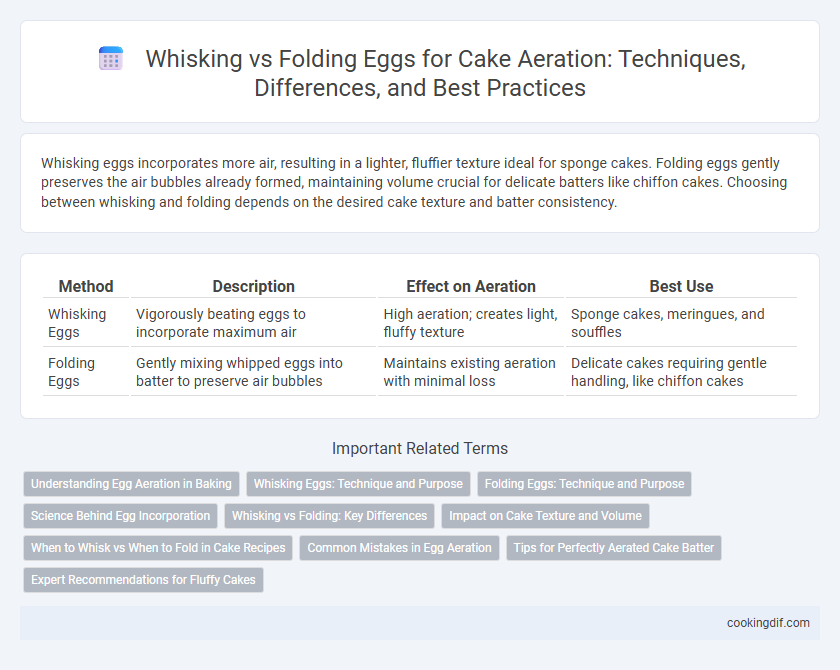Whisking eggs incorporates more air, resulting in a lighter, fluffier texture ideal for sponge cakes. Folding eggs gently preserves the air bubbles already formed, maintaining volume crucial for delicate batters like chiffon cakes. Choosing between whisking and folding depends on the desired cake texture and batter consistency.
Table of Comparison
| Method | Description | Effect on Aeration | Best Use |
|---|---|---|---|
| Whisking Eggs | Vigorously beating eggs to incorporate maximum air | High aeration; creates light, fluffy texture | Sponge cakes, meringues, and souffles |
| Folding Eggs | Gently mixing whipped eggs into batter to preserve air bubbles | Maintains existing aeration with minimal loss | Delicate cakes requiring gentle handling, like chiffon cakes |
Understanding Egg Aeration in Baking
Whisking eggs incorporates air rapidly, creating a light, frothy texture essential for sponges and chiffon cakes, while folding eggs preserves delicate air bubbles to maintain volume in mousses and souffles. Proper egg aeration enhances cake rise and crumb structure by trapping air, which expands during baking to produce a tender, airy result. Understanding the difference ensures precise technique selection, maximizing cake height and texture through optimized air incorporation.
Whisking Eggs: Technique and Purpose
Whisking eggs incorporates air into the mixture, creating a light and airy texture essential for cakes like sponge and chiffon. The vigorous motion of whisking breaks down egg proteins, allowing them to stretch and trap air bubbles, which expand during baking to give the cake volume. This technique is crucial for achieving fluffy cakes with a delicate crumb structure.
Folding Eggs: Technique and Purpose
Folding eggs involves gently combining beaten eggs into a batter using a spatula to preserve the trapped air and maintain maximum volume, essential for light and airy cakes. This technique minimizes air loss compared to whisking, which vigorously agitates the mixture, potentially deflating delicate egg foams. Proper folding ensures a tender crumb and soft texture by retaining the egg's aeration during mixing.
Science Behind Egg Incorporation
Whisking eggs rapidly incorporates air by breaking down proteins, creating a foam that traps tiny air bubbles essential for cake rise and light texture. Folding eggs gently integrates beaten eggs or egg whites without deflating the air bubbles, maintaining the batter's aeration crucial for volume retention. The science behind egg incorporation relies on balancing protein structure and air entrapment to achieve optimal cake crumb and softness.
Whisking vs Folding: Key Differences
Whisking eggs incorporates air rapidly, creating a light and frothy texture essential for sponge cakes, while folding eggs gently preserves existing air bubbles to maintain volume in delicate batters. Whisking uses a vigorous circular motion with a whisk to increase aeration, whereas folding employs a slow, careful lifting motion with a spatula to combine ingredients without deflating the mixture. Understanding these techniques optimizes cake texture by controlling the amount of aeration in egg-based batters.
Impact on Cake Texture and Volume
Whisking eggs incorporates more air, resulting in a lighter, fluffier cake with increased volume and a tender crumb. Folding eggs gently preserves the air bubbles already present, ensuring the structure remains delicate and preventing deflation for a moist, soft texture. Choosing the appropriate method directly influences the cake's rise and overall mouthfeel, with whisking favoring airy sponge cakes and folding suited for denser, creamier varieties.
When to Whisk vs When to Fold in Cake Recipes
Whisking eggs rapidly incorporates air, creating a light, airy structure ideal for sponge cakes and chiffon cakes that require maximum leavening. Folding eggs gently combines beaten eggs or whipped egg whites into batter without deflating the incorporated air, essential for maintaining volume in delicate cake mixtures like souffles and angel food cakes. Choose whisking for initial aeration and folding for mixing in aerated eggs to preserve cake texture and rise.
Common Mistakes in Egg Aeration
Whisking eggs vigorously introduces more air, creating a light and fluffy texture essential for cakes, while folding eggs gently preserves aeration without deflating the mixture. Common mistakes in egg aeration include over-whisking, which can cause eggs to break down and lose volume, and aggressive folding, which leads to deflation and dense cake batter. Proper technique balances incorporating air and maintaining structure for optimal cake rise and texture.
Tips for Perfectly Aerated Cake Batter
Whisking eggs vigorously incorporates more air, resulting in a lighter, fluffier cake crumb, while folding eggs gently preserves delicate air bubbles critical for tender texture. Use a balloon whisk to rapidly mix eggs until frothy for maximum aeration, and fold in dry ingredients with a spatula using slow, deliberate motions to avoid deflating the batter. Maintaining a consistent temperature for eggs and ensuring all ingredients are at room temperature further enhances the aeration and rise of the cake.
Expert Recommendations for Fluffy Cakes
Whisking eggs vigorously incorporates more air, creating a lighter, fluffier cake texture preferred by expert bakers for sponge and chiffon cakes. Folding eggs gently into the batter preserves delicate air bubbles, maintaining volume without deflating the mixture, crucial for mousse and souffle-style cakes. Expert recommendations emphasize using whisking for maximum aeration in batter and folding for delicate texture retention to achieve optimal cake fluffiness.
Whisking eggs vs Folding eggs for aeration Infographic

 cookingdif.com
cookingdif.com